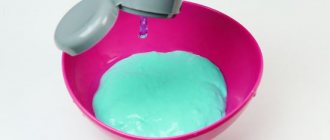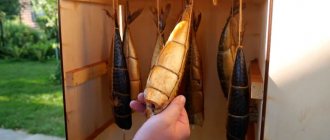Quote from EFACHKA
Read in full In your quotation book or community!
Dried fish is dry: what to do and how to soften the product?
Quite often, lovers of dried fish, not being able to prepare the product themselves, are forced to purchase it in a store or market. At the same time, the buyer constantly runs the risk of encountering a serious problem - the fish dries out so much that it cannot be softened by the usual blows on the table.
Most often, even under strong mechanical stress, the overdried product does not change its characteristics for the better, remaining the same dry, and the meat does not separate from the bones. But there are several popular ways to soften dried fish.
Soaking
There is another popular method used if the dried fish is dry. What to do and how to solve the problem? First, excess salt must be washed off the carcass. After this, the product is placed in a deep container and filled with water or milk.
If the fish is too large, it should first be cut into smaller pieces. Leave the container in the refrigerator for at least 3 hours. If the taste of dried fish has become very strong due to drying, soaking can last all night. After the procedure, the product should be washed in running water.
How to remove excess salt from red fish?
How to soak fish in water:
- Take a container of such a shape that the fish fits completely into it.
- Pour cold water into it, add vinegar to the water. Approximately 1 part vinegar to 10 parts water. ...
- Place the fish in a container.
- Wait a few hours. The fish should be in the refrigerator.
Interesting materials:
What is the subject and object of study and research in natural science? What causes the appearance and disappearance of active formations in the solar atmosphere? What are the characteristics of a state? What is the outcome of the goal setting stage? What suits brown-haired women? What's interesting in Android 11? What is used in the Orlan ISS spacesuit to regulate the temperature of the astronaut and the internal space? What did Phoenician sailors invent? What does the discipline of strength of materials study? What do they study in massage courses?
Steaming
This scheme is somewhat more complicated to implement, but is successfully used in situations where dried fish has dried out. What to do is described in the following instructions: you need to boil water in an enamel pan, after which you should place the fish in it for 20 minutes. After time, the carcass is wrapped in a towel so that it absorbs excess moisture. Next, the product is placed in a plastic bag and left for an hour in a warm place.
This method can also be done using a double boiler. Its bottom must be covered with several layers of gauze, on which the fish, previously cut into smaller pieces, is placed. The product is covered with several more layers of gauze. After adding water, the fish is steamed for about an hour. If everything worked out for you, you can now read how to properly dry fish by following the link: https://www.syl.ru/article/152226/new_kak-sushit-ryibu-protsess-i-podgotovka.
Selecting a quality product
In order not to find yourself in a situation where you cannot eat the fish, you should carefully consider the choice of product when purchasing. In modern realities, it is worth considering the fact that unscrupulous manufacturers use tricks to present the product in a favorable light. Often, carcasses that have already slightly deteriorated are sent for salting. The withering process will perfectly hide such shortcomings as:
- “second” freshness,
- violation of storage conditions,
- non-compliance with the cooking process.
In order not to pay for a product of dubious quality and taste, you should pay attention to the following details:
- Smell. The fish should smell exactly like a river or sea, that is, there should be no extraneous sour or musty aromas present. A change in the normal natural odor indicates that the required temperature was not maintained during the drying process, which means that various microorganisms may be present in the fish meat.
- Appearance. Any plaque on the scales is not acceptable. He says that storage conditions were violated.
- White belly and light gills. If the fish has acquired a yellowish color, it means that fat oxidation has occurred. The taste of such fillet will be rancid.
Denis Borisov
Assistant chef of the restaurant "Fisherman's House"
Ask a Question
Violation of the processes of preparing and storing fish affects not only the taste of the product. Eating such fish is dangerous due to the consequences of poisoning.
What to do with dry fish
If dried fish meets all quality standards, but is impossible to hard, you can revive it with improvised means. How to soften dry dried fish? What is the essence of the problem: is it possible to soften the fillet and should it be re-soaked and dried to do this?
Fish becomes dry for two main reasons:
- Excess salt in the recipe. Salt draws out natural moisture from all foods without exception.
- Time delay. If the fish is weathered for too long, then under the influence of natural factors, the moisture from the fillet evaporates.
That is, in order to make the fillet softer, you need to saturate it with water and reduce the salt content.
Simply putting dried fish in water will not work. The product, of course, will be saturated with water, but will lose its taste. However, there are ways to restore the softness of the fish and maintain a pleasant dried taste. The simplest six are:
- soaking,
- cloth wrapping,
- steaming,
- in the oven,
- rice resuscitation,
- new marinade.
The choice of method depends not only on the available opportunities, but also on the tasks assigned. If you only need to saturate with moisture, then sending or wrapping will do, but if you also need to reduce the amount of salt or adjust the taste, then other methods will be required.
Before choosing a restoration method, you should carefully inspect the product, assessing its quality!
Using improvised means How to make a carcass saturate with moisture without spoiling its taste? All methods have one common sign - it won’t work quickly. There is a direct relationship: the slower the fish “soaks,” the better the result will be.
Wrapping with damp cloth
This softening process is long and will take more than one hour. But you can eat the fish immediately after it’s finished; you won’t have to dry out the fillets. In order to properly soak fish in fabric, the material chosen is soft, natural, and retains moisture well. The rag for wrapping should not be wet, but damp.
The process itself takes place in a cool place, perhaps in the refrigerator. Ideally, the fish should be wrapped in the evening and left overnight. To reduce moisture evaporation, fish in cloth can be placed in a plastic bag.
Soaking
For the second method you will also need soft natural fabric. Kitchen towels work great. Bring water to a boil in a wide saucepan. The size is selected depending on the length of the fish; it must be completely submerged in the water. Dried carcasses are immersed in boiling water for 15–20 minutes and then wrapped in a towel. The fish and towel should be wrapped in cling film or closed in a plastic bag. After all procedures, the product is left wrapped in a warm place for 1.5-2 hours.
Steaming
In order to restore the moisture inside the fillet using this method, you will need a steamer or water bath device. The fish is cut into pieces and placed on the bottom of the selected dish. You can lay it out in several layers, placing it with gauze. Evaporation will nourish the fillet, the fish will restore its former softness, maintaining the taste and amount of salt. It will take at least 1 hour.
Oven
The fastest and most risky way. The fish is wrapped in foil, pricked with a fork over the entire area, and placed on a wire rack. A tray with water is installed under the grate. The oven is turned on to the lowest setting. There should be water in the pan during the entire process, which lasts about 30 minutes. If the water completely evaporates, the fillets will dry out even more. In addition, if you accidentally overdo it, the fish will not only dry out, but also fry. The product will be completely damaged.
Denis Borisov
Assistant chef of the restaurant "Fisherman's House"
Ask a Question
The same procedure can be done in the microwave. It will take less time and the result will be more predictable.
Rice
This method is perfect when you need to not only soak fish, but also remove excess salt from it. Pre-soak the rice, the cereal should be well saturated with water. Then, the fish carcasses are covered with wet grain and put in the refrigerator. The process will take at least 8 hours. It is better to choose cereals for such resuscitation that are not polished or treated with steam.
Restoring fish using marinade
The longest method that guarantees a high-quality result, but it will be a completely different fish. You can re-salt any fish: from roach to pike perch.
Step by step recipe
- The carcass should be washed under running water.
- Cut the fish into small pieces.
- Soak in the prepared warm marinade solution.
- Place in a cool, dark place for several days.
- Hang the softened pieces out to dry.
For the marinade, the solution is usually mixed in the following proportions:
- 1 liter of boiled water,
- 150 ml vinegar 9%,
- 2 tablespoons mustard,
- peppercorns to taste.
For salting fish, only glass or enamel dishes are used.
Where to store dried fish
It is best to store ram at home in special packaging, since at low humidity it loses weight, and at high humidity it becomes moldy. If salted fish is stored in the open air for a long time, the fish oil contained in it will begin to oxidize, giving the ram an unpleasant taste.
For long-term storage of the battering ram, it must be kept in a cool place with a temperature of 3-8 degrees and a relative humidity of 70-80%. In special packaging, fish can be stored for almost a year.
It is best to use corrugated cardboard, wooden boxes, matting, and craft packaging as special packaging for proper storage of dried fish. You need to understand that thin fabric or paper can be pierced by the sharp protrusions of the fish. One of the best packaging is considered to be kraft paper coated on one side with polyethylene. In it, salted dried fish is stored for 8-10 months without losing its consumer qualities. In a bag of matting, the shelf life is reduced to 2-3 months.
We recommend reading: How to Keep Your Tongue Juicy After Cooking
You can store dried fish at home in the refrigerator. It is well preserved in areas with temperatures up to +4, but in order for the ram to be preserved longer, it is greased with oil, preferably olive oil, placed in glass jars and stored in the refrigerator. You can simply wrap the fish in thick paper and wrap it in plastic wrap.
Dried ram requires storage at a relative humidity of 70-80% and at a temperature of no more than 8°C.
How to soften dried dried fish (ram)?
Otherwise, grandfather no longer has teeth to gnaw on it.
RAM
You can take a thin cellophane bag, wrap your fish and put it in the refrigerator under the freezer for a day or two. The fish will become not only softer, but also tastier. You can wrap it in damp newspaper and put it in the refrigerator again.
Another option is to put it in wet rice for the whole night. Wet the rice thoroughly, bury your salted fish in it and leave it in a cool place, preferably again in the refrigerator. And if the fish is very dry, then you need to wrap it in wet gauze for at least four hours.
Otherwise, grandfather no longer has teeth to gnaw on it.
How to properly store dried fish at home
After the product is ready, the question arises of how to store dried fish so that all the beneficial substances are preserved in it for as long as possible. For a short period of time, the ram can be stored at home, but in order to understand where and how to store salted dried fish, you need to meet certain conditions so that the fish does not become unusable ahead of time. So – where to store dried fish? It should be stored in a cool place with fairly high humidity. If the humidity is insufficient, the fish dries out and becomes unusable. In addition, it is advisable to store the fish in a dark place.
Dried fish storage temperature
Dried ram requires storage at a relative humidity of 70-80% and at a temperature of no more than 8°C.











